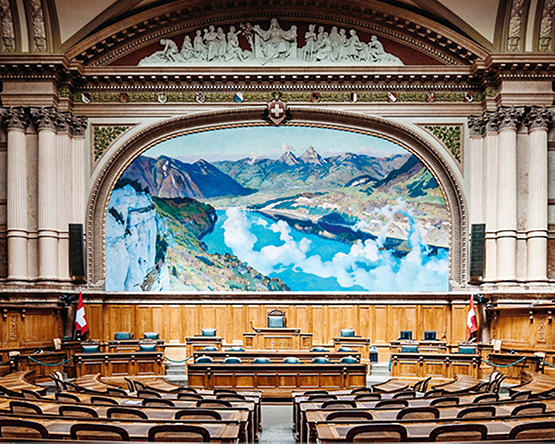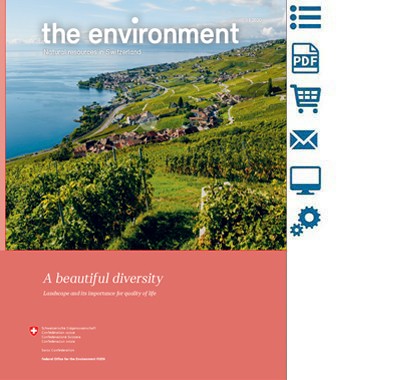The landscape is important in Swiss society. Switzerland has developed an ambitious landscape policy that strives to put the focus on landscape quality throughout the entire country. This policy is distinctive in that it is cross-cutting and coherent across different policy areas and political levels.
Text: Gilles Rudaz and Matthias Stremlow

© Ruben Wyttenbach | Ex-Press | FOEN
From snowy Alpine peaks to historic city centres, Switzerland has a wide range of landscapes. Thus, a typology based on natural features and land uses reveals no fewer than 38 types of landscape across Switzerland’s 41,285 km2 of territory. The landscape is important for the Swiss psyche and identity. Recent initiatives and popular votes on landscape issues show the Swiss population’s intense attachment to “its” landscapes. The diversity and beauty of landscapes promote well-being in the population and are a decisive factor in the decision to locate in Switzerland. Due to the importance of the landscape, policies have to be devised and implemented in order to guide landscape development toward quality.
Landscape policy
The industrialisation and urbanisation of society created more pressing concerns for the landscape at the beginning of the 20th century. In 1936, the Federal Council created the Federal Commission for the Protection of Nature and Cultural Heritage, whose mission was to prepare expert reports for the authorities. In 1962, the protection of the landscape was enshrined in Switzerland’s Constitution. Based on this article of the Constitution, the Federal Act on the Protection of Nature and Cultural Heritage (NCHA) was passed in 1966. In Switzerland, landscape protection is governed by this act and its ordinances, as well as various other special ordinances. Articles2 and 3 of the NCHA make the Confederation responsible for looking after all landscapes within the national territory, and not just landscapes of outstanding beauty that are considered worth protecting.
The NCHA has given rise to various instruments, including the Federal Inventory of Landscapes and Natural Monuments and the Federal Inventory of Mire Landscapes of National Importance. In 2007, Switzerland reviewed the NCHA and introduced parks of national importance. These territories, which cover nearly 12% of the national territory, protect and showcase their precious natural and cultural resources, while stimulating and strengthening regional economies. Switzerland also has a unique instrument in the Swiss Landscape Fund. Established in 1991 by the Swiss parliament in honour of the Confederation’s 700th anniversary, this organisation provides financial support to landscape projects promoted by individuals, associations, communes and regional organisations.
As a federal country, Switzerland is composed of 26 cantons and half-cantons which enjoy a great deal of autonomy, especially when it comes to spatial planning and landscape protection. Based on the NCHA, the Confederation supports the cantons in fulfilling their tasks. For example, it supports the cantons in developing cantonal landscape concepts and implementing landscape measures.
Beyond a single law
One law alone is not enough to ensure that landscapes are comprehensively managed. Other policy areas are concerned as well, due to their impact on the landscape. For that reason, various other laws also incorporate the concepts of landscape protection and management. The Federal Act on Spatial Planning definitely plays a decisive role, especially when it comes to limiting urban sprawl. While this act mainly emphasises areas, it requires landscape and biodiversity issues to be taken into account because they contribute largely to the quality of these areas. Under the Agriculture Act, direct payments were introduced for farmers who conserve landscapes. Other national laws and strategies also make reference to the landscape. For instance, the Federal Council’s Health2030 Strategy underscores the importance of a quality landscape in its 7th goal, which is to “support health through a healthy environment”.
Toward a coherent landscape policy
Since the landscape evolves as a result of many different decisions and actions, it must be ensured that landscape policy is coherent and cross-cutting. In 1997, Switzerland adopted the Swiss Landscape Concept (SLC). This instrument, which is used by the Confederation for planning purposes, establishes the framework for the coherent, quality-based development of landscape as a dwelling place, a space for working, relaxing and moving, a cultural and economic space, and a space where biodiversity can grow. The general and sector-specific goals set out in the SLC are mandatory for all competent authorities of the Federal Administration, which must take the landscape into account in their activities and strategies. To reflect the changes that have occurred in the issues since 1997, the SLC was updated and adopted in May 2020 by theFederal Council. Thirteen sector-specific policies were affected, from agriculture to transport tonational defence. While the SLC primarily concerns federal authorities, it also promotes cooperation between the Confederation, cantons and communes.
Everyone’s business
The main goal of any landscape policy is to actively guide landscape development toward quality. This goal can be achieved only through cooperation within the framework of partnerships and a focus on common goals. Indeed, there are many actors who influence the landscape without even knowing it. Moreover, it is essential to demonstrate what this type of development can offer society and the economy in terms of opportunities and potential. All of these actors also need guidance and support if they are to give due consideration to the landscape in their activities and decisions and ultimately fulfil their responsibility for the landscape. Everyone must be involved if landscape features are to be conserved and developed so that current and future generations can enjoy a high quality of life.
Last modification 11.09.2020






